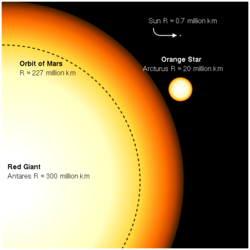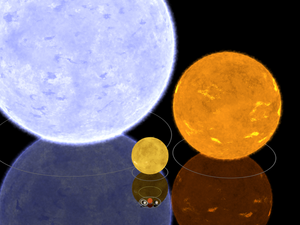Supergiant
 From Conservapedia
From Conservapedia 
Supergiants are a class of star that are among the most massive and luminous stars found.[1] The Yerkes spectral classification place supergiants with the luminosity classes of 1a (luminous supergiants), 1ab (intermediate luminous supergiants), or 1b (less luminous supergiants). The largest and most luminous supergiants are termed hypergiants with a luminosity class of 0, although the term is loosely defined. Supergiants also vary greatly in their radius, ranging from 30 times the diameter of the sun to over 1000 times.
Supergiants form initially the same way other regular stars do, from a cloud of hydrogen gas and interstellar dust that compresses under its gravitational attraction until the center of the cloud is hot enough to fuse hydrogen at its core. What determines if a star will become a supergiant is the amount of mass the star contains. A star needs to contain at least ten solar masses in order to evolve into a supergiant.
Contents
- 1 Types of Supergiants
- 1.1 Red Supergiants
- 1.2 Blue Supergiants
- 1.3 Yellow and White Supergiants
- 2 Hypergiants
- 3 End of Supergiants
- 4 See also
- 5 References
Types of Supergiants[edit]
The two most common types are supergiants are blue supergiants, such as Rigel, and red supergiants, such as Betelgeuse. However supergiants can range from spectral type cool, red class M stars to very hot, blue class O stars.
Red Supergiants[edit]
Red supergiants are the largest stars in the universe in terms of their volume, and are classified as spectral type M or K. These stars form when stars with more than 10 solar masses evolve off the main sequence and expand to their supergiant phase during the helium-burning phase. This phase causes the star's outer layers to expand rapidly, cooling the surface to around 3500-4500 K, causing the expanding giant to redden. Depending on the mass of the supergiant, they will continue to fuse heavier and heavier elements in their core, the most massive fusing elements up to iron. The entire red supergiant phase of a star's life is very brief, lasting only a few hundred thousand to a million years. The most massive of these stars are believed to evolve into Wolf-Rayet stars. Eventually, all but the least massive of these stars will end their lives in a type II supernova.
Blue Supergiants[edit]

Blue supergiants are among the hottest and brightest stars in the universe, they are classified as spectral class O or B. They have surface temperatures between 20,000K and 50,000K. Typically they are not as large as red supergiants and their radii virtually never exceed 25 solar radii in size.[2][3] Because of their extreme luminosity, such stars are highly represented in the night sky from Earth even though they are very scarce. Because of their large mass and intense temperature, they have very short lifespans and are typically observed in open clusters, irregular galaxies, or the arms of spiral galaxies.
Blue supergiants form from the slowing nuclear reactions of a sufficiently massive star that has used all its hydrogen core fuel. The slightly slower nuclear reactions cause the star to contract. With a smaller surface area, the nuclear reactions in the core heat the surface far more than in a red supergiant. A red supergiant may evolve into a blue supergiant if the nuclear reactions at the core slow for whatever reason.[2]
Yellow and White Supergiants[edit]
Yellow supergiants are a supergiant star of spectral class G, while white supergiants are those of the spectral class F.[4] These are typically older supergiants that swing between blue and red phases as they consume elements through fusion in their cores. Some of these are massive enough to be yellow hypergiants, such as Rho Cassiopeiae.
Hypergiants[edit]
The stars with the greatest luminosity and mass are generally referred to as hypergiants (luminosity class 0). Although the term is used loosely, the criterion used to separate supergiants from hypergiants is that the latter are stars with an absolute magnitude greater than -7. Because of this, hypergiants do not have to be the more massive than other supergiants, but the most massive stars are still generally seen as hypergiants.[5] Like supergiants, these most luminious of stars can have a spectral type ranging from class A to M.
Hypergiants are so luminous that they sit very close to the point where radiation from the interior of the star would overcome the inward force of gravity. This theoretical upper limit for the luminosity of a star is called the Eddington limit.[6] Any star that exceeds this limit will be blown apart from its own immense radiation.
End of Supergiants[edit]
All spectral types of supergiants can end their lives as supernova if their cores' mass exceed 1.4 solar masses (known as the Chandrasekhar limit).[7] It was once thought that only red supergiants could end their lives this way. This was disproved with occurrence of Supernova 1987A in the Large Magellanic Cloud on February 23, 1987, when it was discovered the progenitor star was a B3 class, blue supergiant.[8] Supergiants that have a core mass of less than 1.4 solar masses will end their lives as a white dwarf.
See also[edit]
- Red giant
- Supernova
References[edit]
- ↑ Supergiant star. Retrieved on 2019-03-31.
- ↑ 2.0 2.1 THE NATURES OF THE STARS. Retrieved on 2019-03-31.
- ↑ The biggest stars in the universe. Retrieved on 2019-03-31.
- ↑ p. 366, The evolution of massive stars with mass loss, Cesare Chiosi and Andre Maeder, Annual review of astronomy and astrophysics 24 (1986), pp. 329–375. Bibcode: 1986ARA&A..24..329C
- ↑ de Jager, C. (1998). The yellow hypergiants. Astronomy and Astrophysics Review, 8(3), pp.145-180. Bibcode: 1998A&ARv...8..145D
- ↑ Eddington mass limit. Retrieved on 2019-03-31.
- ↑ Lieb, E. and Yau, H. (1987). A rigorous examination of the Chandrasekhar theory of stellar collapse. The Astrophysical Journal, 323, p.140. Bibcode: 1987ApJ...323..140L
- ↑ Smith, N., Immler, S. and Weiler, K. (2007). Galactic Twins of the Nebula Around SN 1987A: Hints that LBVs may be supernova progenitors. AIP Conference Proceedings, 937, pp. 163-170. Bibcode: 2007AIPC..937..163S arXiv:0705.3066 [astro-ph]
| ||||||||||||||||||||||||||
Categories: [Astronomy] [Stars]
↧ Download as ZWI file | Last modified: 03/23/2023 23:55:43 | 52 views
☰ Source: https://www.conservapedia.com/Supergiant | License: CC BY-SA 3.0
 ZWI signed:
ZWI signed: KSF
KSF